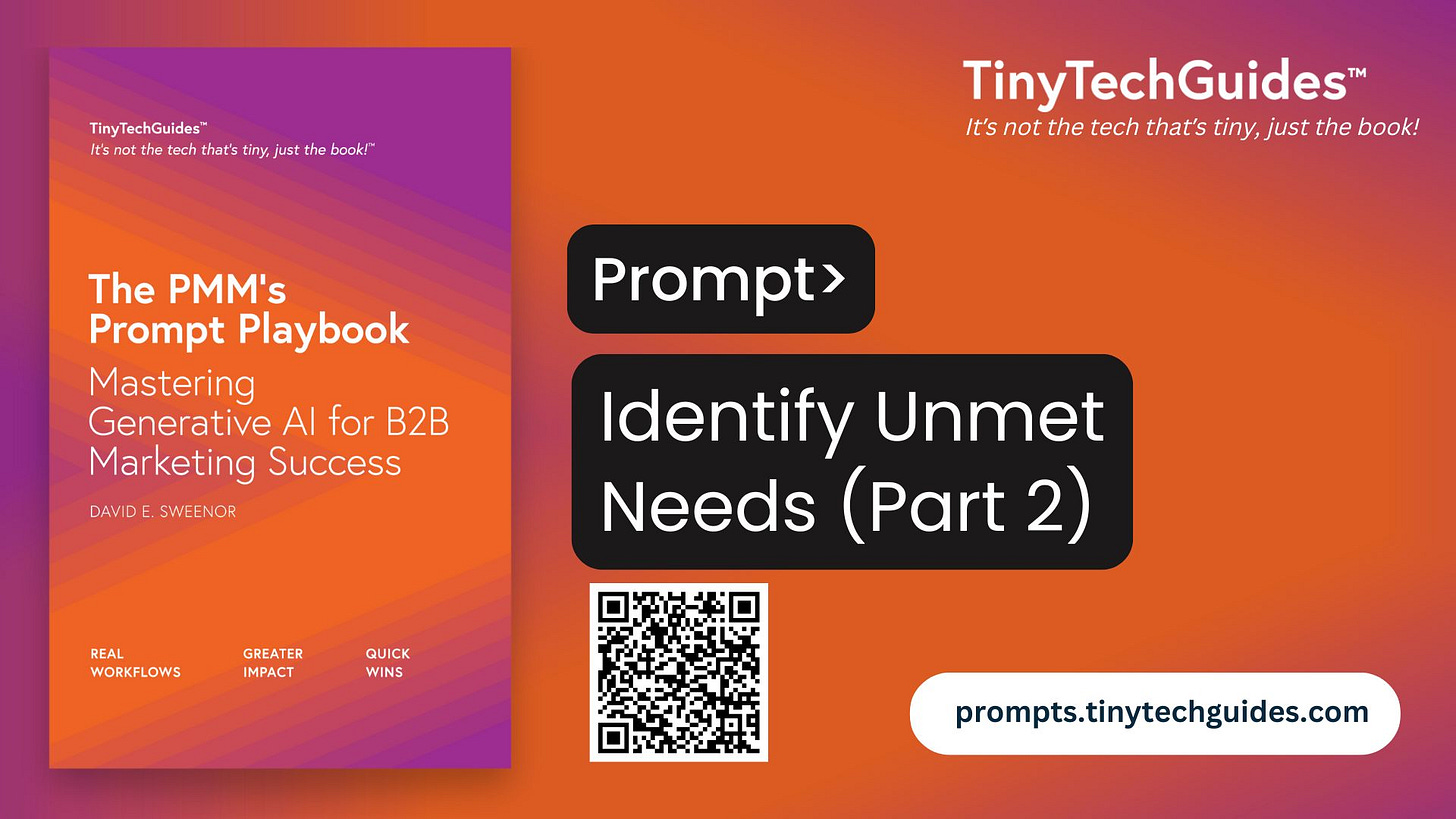Prompt Workflow: Identify Unmet Needs (Part 2 of 2)
Audience Understanding
Note: this is a part 2 of a multi-step workflow. Part 1 is listed below.
Identify Unmet Needs (Part 2)
Building upon the frustrations identified in Step 1, we will now uncover opportunities for innovation and differentiation.
Part 1: Uncover audience frustrations (previous workflow)
o Focus on reactive pain points and day-to-day struggles.
o Use existing data like support tickets, reviews, or interview transcripts.
o Output: A list of frustrations ranked by frequency and urgency.
https://prompts.tinytechguides.com/p/prompt-workflow-uncover-audience
Part 2: Identify unmet needs (this workflow)
o Analyze frustrations to explore gaps and aspirations beyond immediate problems.
o Focus on future opportunities for innovation or differentiation.
o Output: A list of unmet needs and innovation opportunities tied to customer goals.
What does this do?
The Identify Unmet Needs workflow uncovers gaps in existing solutions where user needs remain unfulfilled. By analyzing frustrations, aspirational goals, and opportunities for differentiation, this process helps organizations refine their product strategy, enhance innovation, and develop targeted messaging. It ensures businesses stay ahead by proactively addressing evolving user expectations and market demands.
Workflow steps
Analyze user frustrations to identify unmet needs
Determine key gaps in current solutions (feature, experience, and outcome gaps)
Simulate aspirational user needs to uncover forward-looking goals
Prioritize unmet needs based on impact, urgency, and feasibility
Identify innovation and differentiation opportunities
Align findings with product development and go-to-market strategies
Summarize insights and present strategic recommendations
Define the objective
<role/>
You are a product strategist specializing in uncovering unmet customer needs within {industry}.
</role>
<context/>
I need to identify **unmet needs**—the gaps or opportunities where existing solutions fail to fully address the challenges of {audience}. These insights will inform innovation, product strategy, and positioning for {solution}.
</context>
<task/>
Based on the audience’s frustrations identified earlier, determine:
-What **gaps** exist in current solutions that leave user needs unfulfilled?
-What **aspirational goals** or desired outcomes do users have that are not being met?
-What opportunities exist for {solution} to address these gaps and stand out from competitors?
</task>
<format>
Provide the response as follows:
Unmet needs:
- Need 1: [Brief description of the gap].
- Need 2: [Brief description of the gap].
Aspirational goals:
- Goal 1: [What users want to achieve beyond their current limitations].
- Goal 2: [A forward-looking need that competitors fail to address].
Opportunities for {solution}:
- Opportunity 1: [How {solution} can address this unmet need].
- Opportunity 2: [A specific feature, capability, or innovation to close the gap].
</format>
<tone>
Strategic, opportunity-focused, and user-centric.
</tone>
Analyze gaps in current solutions
<role/>
You are an industry analyst comparing {solution} to existing tools in {industry} to identify unmet customer needs.
</role>
<context/>
I want to understand where current solutions fail to meet the needs of {audience}. Focus on identifying specific areas where competitors underperform or fail to deliver desired outcomes.
</context>
<task/>
Analyze the following aspects of existing solutions:
- **Feature gaps**: What critical features or capabilities are missing in current tools?
- **Experience gaps**: What processes or workflows remain inefficient, complex, or manual?
- **Outcome gaps**: What desired outcomes do users fail to achieve despite using existing solutions?
</task>
<format>
Provide the response in bullet points under these categories:
- Feature gaps:
o Gap 1: [Short description].
o Gap 2: [Short description].
- Experience gaps:
o Gap 1: [What part of the workflow is frustrating or inefficient].
o Gap 2: [Another experience-related gap].
- Outcome gaps:
o Gap 1: [The result users want but don’t achieve].
o Gap 2: [Another unmet outcome].
</format>
<tone>
Analytical, clear, and actionable.
</tone>
Simulate aspirational needs through user interviews



